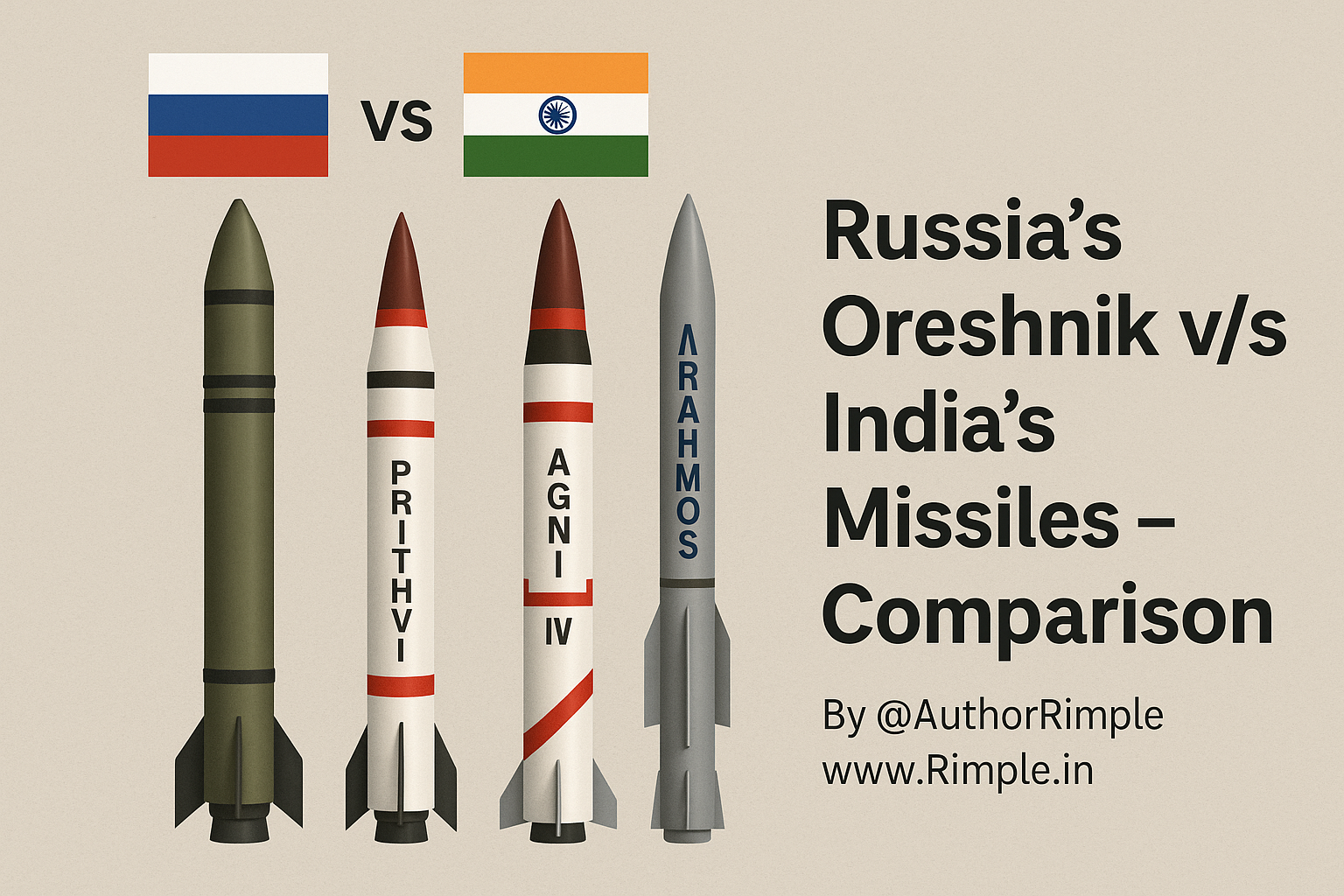Russia’s Oreshnik missile, launched in November 2024, is a powerful intermediate-range ballistic missile (IRBM) that has grabbed global attention for its speed, power, and advanced technology. But how does it stack up against India’s missile arsenal? India has developed impressive missiles under programs like the Integrated Guided Missile Development Program (IGMDP), including the Agni, Prithvi, BrahMos, and others. Let’s compare the Oreshnik with India’s top missiles in a simple, easy-to-read way to see if any match its strength.
Understanding the Oreshnik Missile
The Oreshnik, meaning “hazel tree” in Russian, is a hypersonic IRBM based on the RS-26 Rubezh missile. It was first used in combat on November 21, 2024, against a military factory in Dnipro, Ukraine. Here’s a quick look at its key features:
- Speed: Reaches Mach 10-11 (12,300 km/h or 7,600 mph), making it hypersonic and tough to intercept.
- Range: 1,000–5,500 km (620–3,400 miles), able to hit targets across Europe.
- Warheads: Carries six warheads, each with six submunitions (36 total), capable of massive destruction.
- Payload: Can carry conventional or nuclear warheads, with kinetic energy equivalent to tons of explosives.
- Maneuverability: Uses a Multiple Independently Targetable Reentry Vehicle (MIRV) system, making it hard for defenses like Ukraine’s Patriot systems to stop.
- Purpose: Designed to destroy high-value targets like factories, bunkers, or command centers with precision.
The Oreshnik’s speed, multiple warheads, and ability to evade defenses make it a formidable weapon. Now, let’s see how India’s missiles compare.
India’s Top Missiles: A Quick Overview
India has a strong missile program, with ballistic and cruise missiles developed by the Defence Research and Development Organisation (DRDO). Here are the key missiles we’ll compare:
- Agni-V: India’s most advanced intercontinental ballistic missile (ICBM).
- Agni-Prime: A newer, more maneuverable ballistic missile.
- BrahMos: A supersonic cruise missile, jointly developed with Russia.
- Prithvi-II: A short-range ballistic missile (SRBM).
- Hypersonic Missile (Under Development): A long-range hypersonic missile tested in 2024.
Comparing Oreshnik with Indian Missiles
Let’s break down the comparison based on speed, range, payload, maneuverability, and overall strength, keeping it simple and clear.
1. Agni-V: India’s Long-Range Champion
The Agni-V is India’s most powerful missile, an ICBM designed to reach far-off targets.
- Speed: Around Mach 24 (29,400 km/h) during reentry, much faster than Oreshnik’s Mach 10-11. However, this speed is typical for ICBMs due to their high-altitude trajectory.
- Range: 5,000–8,000 km (3,100–5,000 miles), longer than Oreshnik’s 1,000–5,500 km, making it capable of reaching beyond Europe to places like China or even parts of the U.S.
- Warheads: Can carry MIRV warheads (up to 3–10, depending on configuration), similar to Oreshnik’s six warheads with submunitions. Agni-V’s payload is around 1,500 kg, potentially larger than Oreshnik’s conventional load.
- Maneuverability: Uses MIRV technology, allowing multiple targets to be hit with high accuracy. It’s also highly maneuverable during reentry, making it hard to intercept.
- Strength: Agni-V is more powerful than Oreshnik in terms of range and payload capacity. It’s designed for strategic nuclear strikes, while Oreshnik is more tactical, used for regional targets. However, Oreshnik’s hypersonic speed and submunitions give it an edge in precision strikes against smaller, fortified targets.
Comparison: Agni-V outshines Oreshnik in range and raw power, especially for nuclear missions. But Oreshnik’s submunitions and hypersonic design make it better for quick, devastating conventional strikes.
2. Agni-Prime: The Nimble Newcomer
The Agni-Prime, tested successfully in 2023 and 2024, is a modern ballistic missile with advanced features.
- Speed: Estimated at Mach 10–12, comparable to Oreshnik’s Mach 10-11.
- Range: 1,000–2,000 km, shorter than Oreshnik’s maximum range but within the same IRBM category.
- Warheads: Can carry conventional or nuclear warheads, with a payload of about 700–1,500 kg. It’s designed for MIRV capability, but it likely carries fewer warheads than Oreshnik’s six.
- Maneuverability: Uses advanced guidance and canisterized launch, making it highly mobile and harder to detect. Its maneuverable reentry vehicles make it tough to intercept, similar to Oreshnik.
- Strength: Agni-Prime is close to Oreshnik in speed and maneuverability but lags in payload and warhead numbers. It’s more flexible due to its mobility and smaller size, ideal for quick strikes.
Comparison: Agni-Prime is a strong contender but slightly less powerful than Oreshnik due to its lower payload and fewer warheads. However, its mobility and modern design make it a future rival.
3. BrahMos: The Supersonic Star
The BrahMos, a joint India-Russia project, is a cruise missile, not a ballistic one like Oreshnik.
- Speed: Mach 2.8–3.5 (3,400–4,200 km/h), much slower than Oreshnik’s hypersonic Mach 10-11.
- Range: 290–800 km (depending on the version), far shorter than Oreshnik’s 5,500 km.
- Warheads: Carries a single warhead with a payload of 200–300 kg, much smaller than Oreshnik’s multiple warheads and submunitions.
- Maneuverability: Highly precise, flying low to avoid radar detection, but it lacks the hypersonic speed and MIRV capability of Oreshnik.
- Strength: BrahMos excels in precision strikes against ships, bunkers, or small targets, but it’s not in the same league as Oreshnik for range or destructive power.
Comparison: BrahMos is no match for Oreshnik in speed, range, or payload. It’s designed for different missions, like targeting ships or tactical sites, not large-scale destruction.
4. Prithvi-II: The Short-Range Workhorse
The Prithvi-II is a short-range ballistic missile (SRBM) used for tactical strikes.
- Speed: Around Mach 7 during reentry, slower than Oreshnik’s Mach 10-11.
- Range: 250–350 km, far shorter than Oreshnik’s 1,000–5,500 km.
- Warheads: Carries a single warhead with a payload of 500–1,000 kg, much less versatile than Oreshnik’s six warheads with 36 submunitions.
- Maneuverability: Limited compared to Oreshnik, with basic guidance systems and no MIRV capability.
- Strength: Prithvi-II is reliable for short-range targets but lacks the power, range, and advanced features of Oreshnik.
Comparison: Prithvi-II is significantly weaker than Oreshnik, designed for smaller, closer targets rather than strategic or regional strikes.
5. India’s Hypersonic Missile (Under Development)
India tested a long-range hypersonic missile in 2024, developed by DRDO, but it’s still in the experimental phase.
- Speed: Designed to exceed Mach 5, potentially reaching Mach 10 or more, similar to Oreshnik.
- Range: Over 1,500 km, possibly extendable, but likely less than Oreshnik’s 5,500 km.
- Warheads: Expected to carry conventional or nuclear payloads, potentially with MIRV capability, but details are unclear.
- Maneuverability: Likely to include advanced guidance and maneuverability, similar to Oreshnik’s MIRV system.
- Strength: This missile could eventually rival Oreshnik, but it’s not yet operational, so it’s too early to judge its full capabilities.
Comparison: India’s hypersonic missile shows promise but isn’t ready to challenge Oreshnik’s proven combat performance.
How Oreshnik Impacts Ukraine and India’s Position
The Oreshnik’s use in Ukraine showed its ability to devastate key targets, like the Pivdenmash factory in Dnipro, with minimal defense. Its hypersonic speed and multiple warheads overwhelmed Ukraine’s air defenses, potentially crippling its military production. If used repeatedly, Oreshnik could target Ukraine’s leadership centers in Kyiv, as hinted by Putin, leading to massive disruption and possibly forcing Ukraine to surrender.
For India, the Oreshnik’s debut has sparked interest. Posts on X suggest India’s military is studying Oreshnik-like capabilities for future missiles. India’s Agni-V is already stronger in range and nuclear capability, but Oreshnik’s conventional MIRV system and hypersonic precision are inspiring DRDO to develop similar technology. India’s hypersonic missile, once operational, could close the gap.
Which Indian Missile Matches Oreshnik?
No Indian missile perfectly matches Oreshnik’s unique combination of hypersonic speed, MIRV warheads, and intermediate range, but Agni-V and Agni-Prime come closest:
- Agni-V: Surpasses Oreshnik in range (5,000–8,000 km vs. 5,500 km) and payload capacity, making it stronger for strategic nuclear missions. However, Oreshnik’s submunitions and hypersonic design give it an edge for conventional, regional strikes.
- Agni-Prime: Matches Oreshnik’s speed (Mach 10–12) and has similar maneuverability, but its shorter range (1,000–2,000 km) and fewer warheads make it slightly less powerful.
- BrahMos and Prithvi-II: Far behind in range, speed, and payload, designed for different roles.
- Hypersonic Missile: Could rival Oreshnik in the future but isn’t operational yet.
Why India’s Missiles Are Still Impressive
While Oreshnik is a beast in its class, India’s missiles are no slouch. The Agni-V can reach farther and carry more destructive power, ideal for deterring enemies like China. The Agni-Prime is a step toward matching Oreshnik’s agility and speed. India’s BrahMos is unmatched for precision cruise missile strikes, and the upcoming hypersonic missile could put India on par with Russia’s technology. India’s missile program, built indigenously despite global sanctions, shows its growing strength.
Conclusion: Oreshnik vs. India’s Arsenal
Russia’s Oreshnik is a cutting-edge IRBM with hypersonic speed and multiple warheads, making it a nightmare for defenses like Ukraine’s. India’s Agni-V is stronger in range and nuclear capability, but Oreshnik’s conventional submunitions and precision give it an edge for tactical strikes. The Agni-Prime is close in speed and maneuverability but falls short in payload. India’s hypersonic missile, still in development, could one day match or surpass Oreshnik.
For now, India’s missiles are powerful in their own right, and the DRDO is likely inspired by Oreshnik to push the envelope further. Russia’s “hazel tree” may have shaken Ukraine, but India’s missile program is growing stronger, ready to stand tall on the global stage.
Also Read:





